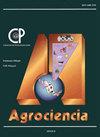AGRONOMIC EVALUATION OF TROPICAL GRASSES ASSOCIATED WITH Canavalia brasiliensis IN DRY TROPIC
IF 0.5
4区 农林科学
Q4 AGRICULTURE, MULTIDISCIPLINARY
引用次数: 0
Abstract
Livestock production in some tropical regions is characterized by the use of naturalized forages in extensive management with low production rates. The use of improved grass-legume associations represents a sustainable intensification opportunity for this type of agroecosystems. The objective was to evaluate the production in establishment of forage associations for grazing systems in the dry tropics of Colombia. In a randomized complete block design with slope as the block factor and experimental units of 2700 m2 with four replications, the agronomic and nutritional quality characteristics of six treatments were compared: Urochloa hybrid cultivar Mulato II, U. brizantha cultivar Toledo and Megathyrsus maximus cultivar Mombasa, established alone or associated with Canavalia brasiliensis, against the control Dichantium aristatum, a naturalized forage of the region. Mulato II, Toledo and Mombasa alone and in association showed greater (p ≤ 0.05) vigour, height, cover and forage production than the control. Mombasa produced 10.7 Mg ha-1 MS (Megagrams of dry matter per hectare), exceeding (p ≤ 0.05) by 74, 53 and 84 % that were recorded in Mulato II, Toledo and control, respectively. C. brasilienses promoted higher productivity in the association with Mulato II and improved nutritional characteristics in the associations with Toledo and Mombasa compared to specific monocultures and the control. The improved grasses alone or associated with C. brasiliensis were a better forage option than Dichantium aristatum. It was concluded that M. maximus and Urochloa hybrid associated with C. brasiliensis are relevant forage options for agroecologically similar regions to the Colombian dry tropics.热带干旱区巴西芥伴生热带牧草的农艺评价
在一些热带地区,畜牧生产的特点是在粗放经营中使用归化饲料,产量低。利用改良的草-豆科植物组合为这类农业生态系统提供了可持续集约化的机会。目的是评价在哥伦比亚干旱热带地区建立放牧系统饲草协会的生产情况。采用随机完全区组设计,以坡度为区组因子,试验面积为2700 m2,共4个重复,比较了6个处理的农艺品质和营养品质特征,分别是单独栽培或与巴西芥联合栽培的乌氏藻杂交种Mulato II、褐花苜蓿托莱多和大菱鲆蒙巴萨,以及对照地区引种牧草马尾松。Mulato II、Toledo和monbasa单独或联合的活力、高度、盖度和饲料产量均高于对照(p≤0.05)。蒙巴萨的干物质产量为10.7 Mg ha-1 MS,比Mulato II、Toledo和对照分别高出74%、53%和84% (p≤0.05)。与特定单一栽培和对照相比,与Mulato II组合的巴西芽孢杆菌促进了更高的生产力,并改善了托莱多和蒙巴萨组合的营养特性。改良禾草单独或与巴西木伴生是较好的饲料选择。综上所述,在农业生态与哥伦比亚干旱热带相似的地区,与巴西青霉杂交的大鼠和尾藻是适宜的饲料选择。
本文章由计算机程序翻译,如有差异,请以英文原文为准。
求助全文
约1分钟内获得全文
求助全文
来源期刊

Agrociencia
农林科学-农业综合
CiteScore
0.50
自引率
33.30%
发文量
51
审稿时长
18-36 weeks
期刊介绍:
AGROCIENCIA is a scientific journal created and sponsored by the Colegio de Postgraduados. Its main objective is the publication and diffusion of agricultural, animal and forestry sciences research results from mexican and foreign scientists. All contributions are peer reviewed. Starting in the year 2000, AGROCIENCIA became a bimonthly and fully bilingual journal (Spanish and English versions in the same issue). Since 2007 appears every month and a half (eight issues per year). In addition to the printed issues, the full content is available in electronic format.
 求助内容:
求助内容: 应助结果提醒方式:
应助结果提醒方式:


